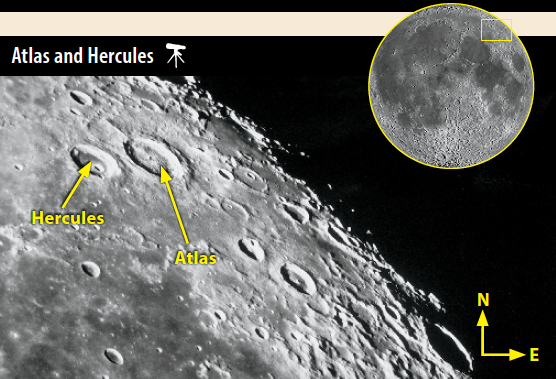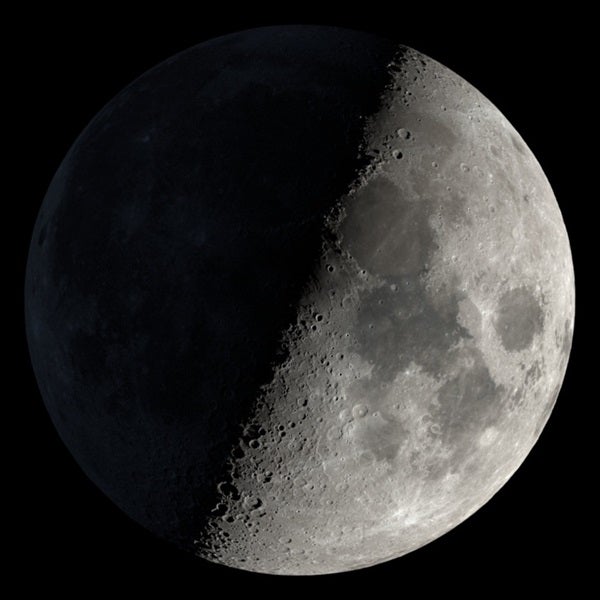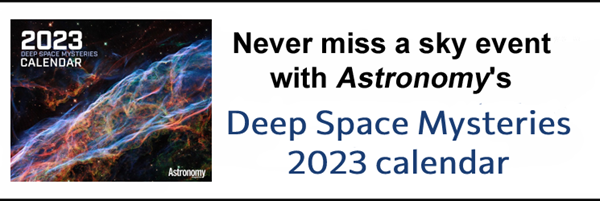Friday, November 25
Asteroid 4 Vesta is plying the skies of southeastern Aquarius. You’ll find it near the planetary nebula NGC 7293, better known as the Helix Nebula, this evening, when Vesta sits just over 3° north-northeast of the dying star.
Vesta, which is also 3.8° northeast of Upsilon (υ) Aquarii, glows at magnitude 7.6. It’s relatively easy to pick up with binoculars or any small scope. The Helix Nebula is 1.2° west of Upsilon and appears as a faint, fuzzy blur at magnitude 7. However, it’s deceptively difficult to catch because of its low surface brightness, owing to the fact that the nebula’s light is spread over 13′ of sky — and that’s because this object lies close to Earth (just 700 light-years away).
Because the Helix can be challenging to spot, be patient, give your eyes time to adjust, and try using averted vision. When using binoculars, opt for 7x to 15x magnification and front lenses wider than 50 millimeters, or switch to a small telescope for a better view.
Sunrise: 6:56 A.M.
Sunset: 4:37 P.M.
Moonrise: 9:07 A.M.
Moonset: 6:04 P.M.
Moon Phase: Waxing crescent (5%)
*Times for sunrise, sunset, moonrise, and moonset are given in local time from 40° N 90° W. The Moon’s illumination is given at 12 P.M. local time from the same location.
Saturday, November 26
If you’re up for a realy challenge — and have a clear view of the southwestern horizon — try spotting Mercury and Venus together shortly after sunset.
You’ll need to be quick, as some 20 minutes after the Sun disappears, the pair of planets is just 1° high. If you can get to an observing site with some elevation, it may help. Despite their low altitude, the two shine brightly against the fading light — Venus’ magnitude –3.9 light should stand out well. Mercury is magnitude –0.7 — still bright, but it might require binoculars to pick it out against the bright sky background. The planets are just over 2° apart, with Mercury sitting west (to the lower left) of Venus.
Day by day, the planets will appear higher in the sky after sunset even as they drift apart. So, if you can’t quite catch them today, don’t worry — there will be many more chances in the coming month.
Higher in the sky (and thus easier to spot for longer) is the slowly waxing Moon. Our satellite is 13 percent illuminated half an hour after sunset, hanging 14.5° high in the southwest in the vicinity of the Teapot’s handle in Sagittarius. You’ll likely need another hour or so for those stars to really pop out; although the region will have sunk closer to the horizon, it is still visible, with the Moon less than 1° from 3rd-magnitude Tau (τ) Sagittarii.
Sunrise: 6:58 A.M.
Sunset: 4:37 P.M.
Moonrise: 10:14 A.M.
Moonset: 7:11 P.M.
Moon Phase: Waxing crescent (11%)
Sunday, November 27
If you’re observing shortly after the clock hits midnight on the 26th (i.e., early morning on the 27th), you can catch a special sight: Jupiter’s icy moon Callisto skimming due south of the gas giant. Between about 2 A.M. and 4 A.M. EST, the Galilean moon slides beneath the planet’s limb from east to west, leaving just a sliver of darkness between the two around 3 A.M. EST.
What’s happening here? Callisto isn’t actually moving south of the planet — it just appears that way, thanks to the tilt of its orbit. As the farthest of the four Galilean satellites, Callisto has the widest orbit. When Earth and Jupiter are tilted just so relative to each other, Callisto doesn’t transit or undergo occultations, but instead appears to travel south or north of its host planet.
If you’re wondering about Callisto’s fellow moons, Europa currently sits far to Jupiter’s east, while Io (closer) and Ganymede sit to the west.
As an added bonus, the Great Red Spot is also transiting early this morning. Shortly after 1 A.M. EST, the giant storm is roughly in the middle of the disk. It should remain visible for another hour or two, as the planet’s rapid rotation carries it along from east to west.
Sunrise: 6:59 A.M.
Sunset: 4:36 P.M.
Moonrise: 11:10 A.M.
Moonset: 8:25 P.M.
Moon Phase: Waxing crescent (19%)
Monday, November 28
An hour after sunset tonight finds the Moon sharing Capricornus with the ringed planet Saturn. Our satellite is now 32 percent lit and about 6.7° southwest of the planet, which glows a soft magnitude 0.7. Just east of Saturn, some 4.3°, is the 3rd-magnitude star Deneb Algedi.
You can enjoy the grouping for a few hours before it sets; as the hours pass, the scene rotates, with the Moon setting first and Saturn following about 25 minutes later. Before it disappears, turn a telescope on Saturn to enjoy its stunning rings, which stretch 38″ across. The planet’s biggest, brightest moon, Titan, sits 2.7′ due east of the planet tonight. We’ll come back in a few nights, when it will have moved due south of the disk.
At midnight tonight, the Moon will pass 4° due south of Saturn.
Sunrise: 7:00 A.M.
Sunset: 4:36 P.M.
Moonrise: 11:55 M
Moonset: 9:42 P.M.
Moon Phase: Waxing crescent (29%)
Tuesday, November 29
Shortly after sunset, the Moon is high in the southern sky and its eastern (west on the sky) limb is brightly illuminated. In the lunar southeast is the large crater Petavius, whose central peak makes it look a bit like a bull’s-eye.
Look to this crater’s southwest with your telescope and you’ll find a pair of smaller gouges in the lunar surface: Stevinus and Furnerius (see the image above for help identifying them). If the glare is too much, try increasing the power or wearing sunglasses — they work just as well for reflected sunlight!
Near Stevinus and Furnerius are two even smaller craters, Stevinus A and (you guessed it) Furnerius A. Stevinus A is the brighter of the two and farther in from the limb. Look over the landscape to enjoy its rugged beauty, while also scanning for bright rays of ejecta from these small craters. These blankets of flung-out material are bright because they are young. Over time, the high-speed particles in the solar wind slamming into the lunar soil will turn them dark.
Sunrise: 7:01 A.M.
Sunset: 4:36 P.M.
Moonrise: 12:30 P.M.
Moonset: 10:77 P.M.
Moon Phase: Waxing crescent (40%)
Wednesday, November 30
First Quarter Moon occurs at 9:27 A.M. EST, when the lunar surface appears exactly 50 percent lit. Several hours later, at 7 P.M. EST, the Moon passes 1.2° north of asteroid 3 Juno in Aquarius. Use a telescope to see if you can spot the main-belt world’s 9th-magnitude glow amid the glare from the Moon.
But the real star of tonight’s skies is the Red Planet, Mars. Earth’s neighbor makes its closest approach to us at 9 P.M. EST, reaching a point just 50.6 million miles (81.4 million kilometers) away. That’s roughly half the average distance between Earth and the Sun.
Mars resides in Taurus and is well above the eastern horizon for most observers by that time. You can find it glowing at magnitude –1.8 just 5.3° southwest of Elnath, the Bull’s more western horn tip.
Now is the time to image Mars if you’re able — the planet stretches 17″ across and will stay this size for a short time, at least through opposition in just over a week. Both of its polar caps are visible, as well as several surface features (if the dust of the stormy season getting underway isn’t too thick). Around midnight in the Midwest, Syrtis Major and Hellas should stand roughly in the middle of the disk. Because the planet is so near opposition, you can enjoy it from dusk until dawn, as it rises and sets roughly opposite the Sun from our point of view.
Sunrise: 7:02 A.M.
Sunset: 4:35 P.M.
Moonrise: 12:59 P.M.
Moonset: —
Moon Phase: Waxing gibbous (52%)
Thursday, December 1
The Moon is hustling through the sky, first passing 3° south of Neptune at 8 A.M. EST and then slipping 3° south of Jupiter at 8 P.M. EST. Since we’ve visited the latter already this week, let’s enjoy the solar system’s most distant planet tonight, which hangs high in northeastern Aquarius, forming a triangle with the Moon (now 5.5° to Neptune’s east an hour after sunset) and Jupiter, some 3.3° north-northeast of our satellite.
Neptune glows a dim magnitude 7.9 and will require binoculars or a small scope to pick out. It sits between two 7th-magnitude field stars, aiding in its identification. The ice giant’s disk appears just 2″across — compare that with Jupiter’s blazingly bright (magnitude –2.6) 43″-wide face! Jupiter is not only larger than Neptune, it’s also much closer, which boosts its apparent size considerably. Neptune and Jupiter appear just over 6° apart early this month; they will move slowly apart and reach a separation of about 8° by the end of the year.
Sunrise: 7:03 A.M.
Sunset: 4:35 P.M.
Moonrise: 1:25 P.M.
Moonset: 12:08 A.M.
Moon Phase: Waxing gibbous (63%)
Friday, December 2
Saturn’s large moon Titan has progressed in its orbit, now appearing due south of Saturn around 8 P.M. EST this evening. Nearer to the planet and its rings are several of its smaller, fainter moons, including Tethys, Rhea, and Dione. Dim Hyperion, nearly 15th magnitude, sits some 3° due west — only visible for those with large scopes or taking long-exposure photographs.
Also visible in Capricornus tonight is the globular cluster M30. Located 7.5° southeast of Saturn and 6.3° south of Nashira (Gamma [γ] Capricorni), this dense ball of stars has a total magnitude of about 7.2. Covering about 12′, M30 appears to have a dense core and fairly sparse outskirts. Thanks to this, most of its light is concentrated in the center, making it easy to spot and fun to discern detail within. It’s a great target for even a small scope, so take some time and enjoy this ancient object.
Sunrise: 7:04 A.M.
Sunset: 4:35 P.M.
Moonrise: 1:48 P.M.
Moonset: 1:17 A.M.
Moon Phase: Waxing gibbous (73%)














